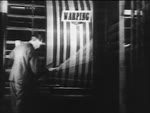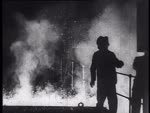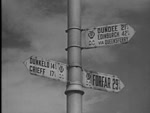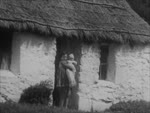RIVER CLYDE, the
Full length video
Please read Understanding catalogue records for help interpreting this information and Using footage for more information about accessing this film.
Title: RIVER CLYDE, the
Reference number: 0398
Date: 1937*
Production company: Elder Dalrymple Productions
Sound: silent
Original format: 16mm
Colour: bw
Fiction: non-fiction
Running time: 12 mins
Description:
Following the River Clyde from its upper reaches down to the Firth.
N.B. This is a different film from title of the same name at ref. 0580.
Credits:
scenario David C Cousland MA, John C Elder
ph. Isabel Elder, John C Elder
[Distributed by Educational and General Services Limited]
Shotlist:
Credits (.21); The River Clyde is 112 miles long from its source in the Lowther Hills to the end of its channel at Greenock (.32); Map of the Clyde (.48); From its rising it flows for some 25 miles through moors and hills. Brief shot of landscape. Boy drinks from moorland stream (1.11); General views of moorland and man walking (1.30); Fish in burn (1.32); For a part of this stretch it runs beside the main road and rail routes from England to Glasgow. Cars and buses on road (1.52); Long shot of steam locomotive pulling train across bridge (1.59); The stream drains a countryside in which sheep are reared. General view of shepherd with his sheep (2.25); Its waters give sport to the angler. Fisherman in mid-stream (2.35); At the Falls of Clyde, near Lanark, the river has cut a way for itself down a ravine to its lower valley. Map of same (2.51); Waterfall and surrounding countryside (3.05); Above the falls a dam has been built and water led to an electricity generating station further down the river. Medium shot up to dam. General views of dam (3.30); Exterior of Stonebyres power station (3.37); After its turbulent passage the river flows peacefully through a fruit growing valley. General views of river and countryside (3.56); Workers pick pears, gooseberries, raspberries and strawberries in the fields (5.04); The growing of tomatoes in glasshouses has become an important industry in this fertile district. General views of glasshouses and shots inside of tomatoes being picked (5.33); At Bothwell Bridge, where a battle was fought in 1679, the bank of the river has been made a children's beach. Shot of bridge and pan across and down to children on beach (5.54); The new broad river provides water and power to the works on its banks. General views of water and shots of mill buildings bordering it. Traffic crossing bridge and more buildings (6.12); Glasgow is the lowest point at which the river is bridged. Below it the Clyde can only be crossed by ferries. Map of location of ferry and bridge crossings (6.42); Traffic on King George V bridge in central Glasgow. A steam locomotive passes across railway bridge behind it, several shots of same (6.56); Passenger ferry No. 10 pulls away from bank into mid-channel. Shot of vehicular ferry at pier behind it. Vehicular ferry crosses. Both ferries dock. Steam traction engine and trailer are off-loaded and driven away (7.32); Seawards from Glasgow the river, deepened, widened and with docks, has been made a waterway for ships. Steam power vessel sails up river past crane, probably Finnieston. Tug pulling liner (7.56); On the banks between Glasgow and Greenock stand many shipyards. Map with locations of shipyards (8.22); Shot of yard with vessel in dock (8.33); At Greenock, the channel ends and the river merges in the Firth of Clyde. High shot across Firth as vessels ply back and forth. Shots of paddle steamer passing behind Irish cross-channel boat at Tail o' the Bank (8.49); The Cloch lighthouse (8.56); Vessel passes camera (9.02); With its sea lochs and islands the Firth of Clyde is a holiday district for the millions who live and work in Industrial Scotland. Map showing distribution of holiday towns (9.36); Shots of Dunoon pier with paddle steamer "Mercury", passing in the distance (9.40); Close-up of paddle steamer (9.47); Single funnelled steamer passes camera (9.55); Shot from stern of steamer at Rothesay pier, and shots along the promenade (10.05); High shot from hill down to the steamer at Rothesay pier, shots of beach crowded with children (10.20); General views of people on Largs promenade (10.36); The sheltered waters of this lovely Firth offer ideal sailing conditions for yachts of all sizes. Yachts in bay (10.50); Model yachts in boating pond (10.58); Yachts (11.06); So the River Clyde, in flowing from its source to the sea, passes through five distinct stages, Moorland, fruit valley, industrial area, shipping channel, holiday estuary. (11.30); And then out through the north channel - away far out to the rolling Atlantic Ocean. (11.37); Shot of the estuary (11.40); The End (11.49)
Running time approx 12 minutes






